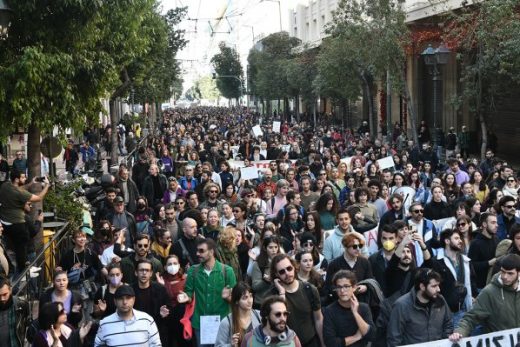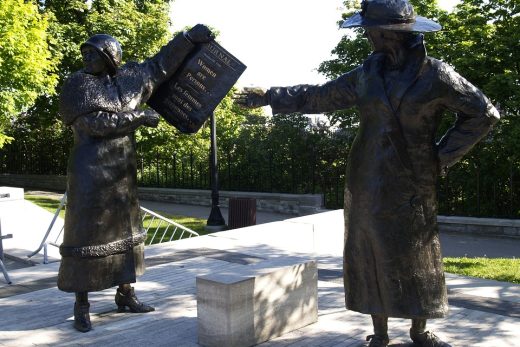The Irish Repertory Theater is streaming poetry readings, and Playwrights Horizons and St. Ann’s Warehouse are showcasing art dealing with race and injustice.
Like many cultural organizations, the Irish Repertory Theater in Manhattan has streamed pandemic programming on its website.
But a few days ago, the theater added a new sort of broadcast to its repertoire, setting up two 60-inch screens in windows that face the sidewalk, installing speakers high up on the building facade and airing a collection of films that show people reading poems in Ireland, London and New York.
On a recent morning, Ciaran O’Reilly, the Rep’s producing director, stood by the theater on West 22nd Street, gazing at the screens as they displayed Joseph Aldous, an actor in Britain, reading “An Advancement of Learning,” a narrative poem by Seamus Heaney describing a brief standoff with a rat along a river bank.
“These are not dark windows,” O’Reilly said. “They are lit up with poetry, with music, with the words of actors who are performing.”
In the past year, theaters and other performing arts institutions in New York have turned to creative means to bring works to the public, sometimes also injecting a bit of life into otherwise shuttered facades. Those arrangements continue, even as the State of New York has announced that arts venues can reopen in April at one-third capacity and some outdoor performances, like Shakespeare in the Park, are scheduled to resume.
The panes of glass, though, have provided a safe space. Late last year, for instance, the artists Christopher Williams, Holly Bass and Raja Feather Kelly performed at different times in the lobby or in a smaller vestibule-like part of the building in Chelsea occupied by New York Live Arts. All were visible through glass to those outside.SIGN UP FOR THE THEATER UPDATE NEWSLETTER: Every week, stay on top of the top-grossing Broadway shows, recent reviews, Critics’ Picks and more.Sign Up
Three more performances by Kelly of “Hysteria,” in which he assumes the role of a pink-hued extraterrestrial and explores what Live Arts’ website calls “pop culture and its displacement of queer Black subjectivity,” are scheduled for April 8-10.

Another street-level performance took place behind glass last December in Downtown Brooklyn, where the Brooklyn Ballet staged nine 20-minute shows of select dances from its “Nutcracker.”
The ballet turned its studio into what its artistic director, Lynn Parkerson, called a “jewel box” theater; chose dances that kept masked ballerinas socially distanced; and used barricades on the sidewalk to limit audiences.
“It was a way to bring some people back to something they love that they enjoyed that they might be forgetting about,” Parkerson said in an interview. “It did feel like a real performance.”
She said that live performances were planned for April and would include ballet members in “Pas de Deux,” set to Jean-Philippe Rameau’s “Gavotte et Six Doubles,” with live music by the pianist Simone Dinnerstein.
Pop-up concerts have been arranged by the Kaufman Music Center on the Upper West Side, in a storefront — the address is not given but is described on the center’s website as “not hard to find” — north of Columbus Circle.
Those performances, running through late April, are announced at the storefront the same day, to limit crowd sizes and encourage social distancing. Participants have included the violinist Gil Shaham, the mezzo-soprano Chrystal E. Williams, the Gabrielle Stravelli Trio and JACK Quartet.
St. Ann’s Warehouse in Brooklyn is displaying Julian Alexander and Khadijat Oseni’s “Supremacy Project,” public art that addresses the nature of injustice in American society.
The word “supremacy” is superimposed on a photograph of police officers in riot gear, and there are images by Michael T. Boyd of Sandra Bland, Elijah McClain and Emmett Till.
And at Playwrights Horizons in Midtown, the Mexican-American artist Ken Gonzales-Day is placing photographs of sculptures of human figures in display cases, encouraging viewers to reckon with definitions of beauty and race. Those displays are part of rotating public art series organized by the artist, activist, and writer Avram Finkelstein and the set and costume designer David Zinn.
The aim, Finkelstein said in January when the series was announced, was to display work that “makes constructive use of dormant facades to create a transient street museum” and to “remind the city of its buoyancy and originality.”
O’Reilly, at the Irish Rep, said the theater heard last year from Amy Holmes, the executive director of the Adrian Brinkerhoff Poetry Foundation, who thought the theater might provide a good venue to air some of the short films the organization had commissioned to make poetry part of an immersive experience.
The series being shown at the theater, called “Poetic Reflections: Words Upon the Window Pane,” comprises 21 short pieces by the Irish filmmaker Matthew Thompson.

They show contemporary poets reading their own works as well as poets and actors reading works by others, including William Butler Yeats and J.M. Synge, and were produced in collaboration with Poetry Ireland in Dublin, Druid Theater in Galway, the 92nd Street Y in New York and Poet in the City in London.
“I think there is something special about encountering the arts in an unexpected way in the city, especially an art form like poetry,” Holmes said.
The readers in the films include people who were born in Ireland, immigrants to Ireland, people who live in Britain and a few from the United States, like Denice Frohman, who was born and raised in New York City.
Frohman was on the theater’s screens on Tuesday night, reading lines like “the beaches are gated & no one knows the names of the dead” from her poem “Puertopia,” when Erin Madorsky and Dorian Baker stopped to listen.
Baker said he saw the films playing in the window as symbolizing a “revitalization of poetic energy.”
Madorsky had regularly attended theatrical performances before the pandemic but now missed that connection, she said, and was gratified to happen upon a dramatic reading while walking home.
She added that the sound of the verses being read stood in contrast to what she called the city’s “standard” backdrop of blaring horns, sirens and rumbling garbage trucks.
Source: The New York Times





